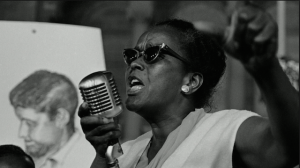
Source: https://zinnedproject.org/materials/baker-ella/
Ella Baker is one of the lesser-known figures of the Civil Rights Movement, but she was involved in several of the leading organizations of the era, including the National Association for the Advancement of Colored People, the Southern Christian Leadership Conference, and the Student Nonviolent Coordinating Committee. Baker was especially influential behind-the-scenes in mentoring SNCC student activists. Baker’s quiet influence is rather fitting, as she was an advocate for group-centered leadership. That is, she worked with the belief that communities ought to organize themselves.
Baker concerned herself primarily with developing the leadership potential of the people with whom she worked for “In contrast to the more traditional conception of leadership as moving people and directing events, hers was a conception of leadership as teaching” (Payne, 1989, p. 892). Through such education, Baker argued, communities could make their own decisions in regards to their common problems, rather than relying on a single leader to fix them. Such self-sufficiency is crucial in empowering communities and creating lasting change. Thus, teaching is an integral part of the role of the leader in organizing efforts.
In order to fine-tune our understanding of the role of the leader in community organizing, it may be helpful to consider what a leader is not. Baker argued emphatically that a leader is not singular, nor consumed by ego and media fame. She recognized that there is a “danger in our culture that, because a person is called upon to give public statements and is acclaimed by the establishment, such a person gets to the point of believing that he is the movement” (as quoted in Mueller, 2004, p. 86). When the leader becomes consumed by his role as head of a movement, he may lose focus, forgetting that the community must also be behind the movement. After all, a head is nothing without its body. The leader plays a crucial role in bringing about collective, not individual, action in community organizing efforts.
Such collective action becomes important, as Baker said, “when the prophetic leader turns out to have heavy feet of clay” (as quoted in Mueller, 2004, p. 89). The Biblical term “heavy feet of clay” implies a weak foundation, suggesting that a singular leader, no matter how impressively equipped, will collapse without a strong community base. Therein lies the danger that comes with reliance on a charismatic leader, the danger of losing the movement altogether. The leader as educator enables communities to become self-sufficient so that they are not reliant on one person to organize them, building a strong and enduring base for change.
In this fame-focused age, perhaps we ought to look to Baker’s quiet example in order to shift our focus from the leader to the community. Many grassroots organizing groups today do implement developmental and/or group-centered leadership strategies, like those Baker championed. I will take a look at a few of these grassroots organizations that work specifically to empower Latino families and strengthen their engagement with schools.
